Employee Relations and Communication
VerifiedAdded on 2020/07/22
|15
|5117
|333
AI Summary
The assignment provides a comprehensive overview of employee relations and communication, covering topics such as negotiation in collective bargaining, employee voice and organizational performance, quality of work life, and industrial relations climate. The study guide includes references to relevant studies and research papers, providing a thorough understanding of the subject matter.
Contribute Materials
Your contribution can guide someone’s learning journey. Share your
documents today.
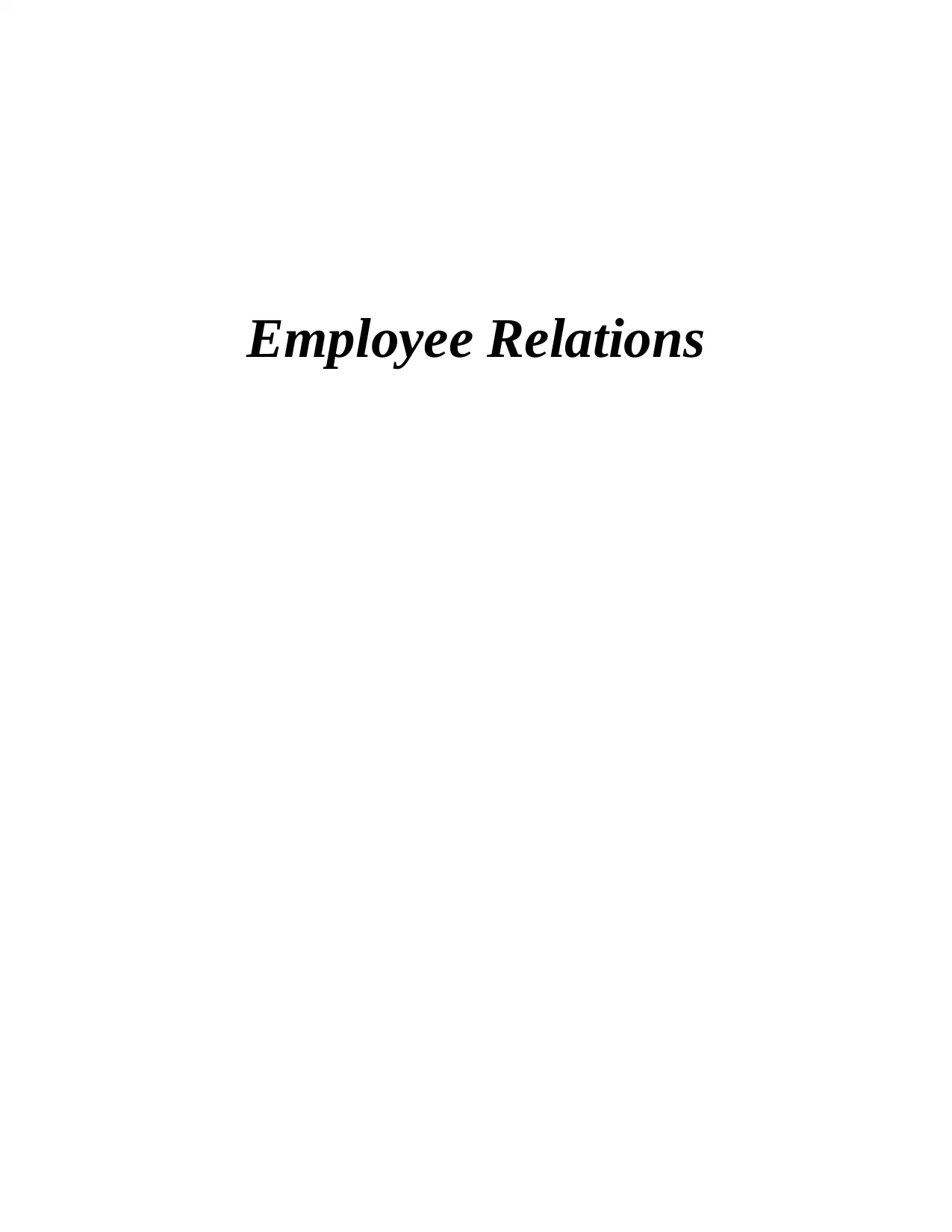
Employee Relations
Secure Best Marks with AI Grader
Need help grading? Try our AI Grader for instant feedback on your assignments.
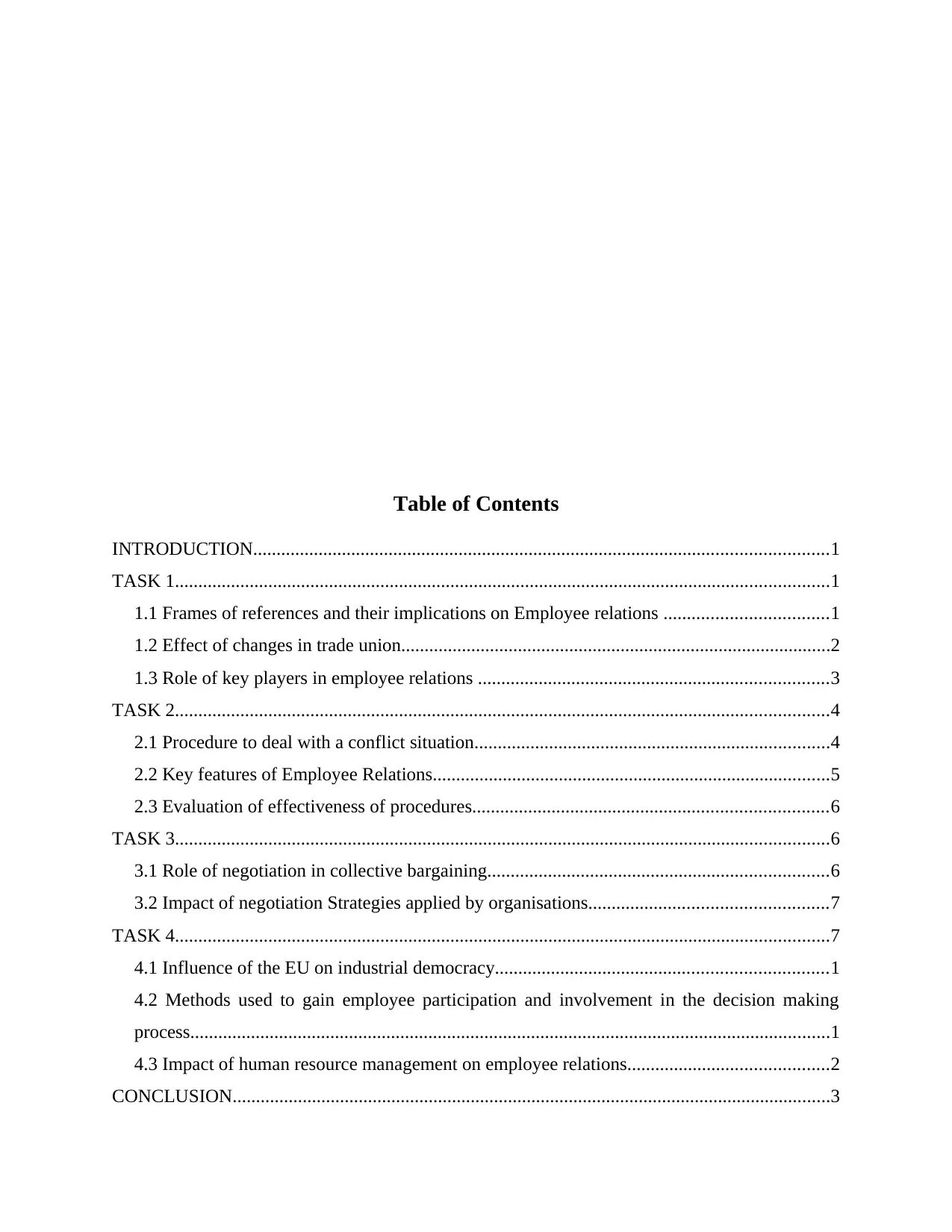
Table of Contents
INTRODUCTION...........................................................................................................................1
TASK 1............................................................................................................................................1
1.1 Frames of references and their implications on Employee relations ...................................1
1.2 Effect of changes in trade union............................................................................................2
1.3 Role of key players in employee relations ...........................................................................3
TASK 2............................................................................................................................................4
2.1 Procedure to deal with a conflict situation............................................................................4
2.2 Key features of Employee Relations.....................................................................................5
2.3 Evaluation of effectiveness of procedures............................................................................6
TASK 3............................................................................................................................................6
3.1 Role of negotiation in collective bargaining.........................................................................6
3.2 Impact of negotiation Strategies applied by organisations...................................................7
TASK 4............................................................................................................................................7
4.1 Influence of the EU on industrial democracy.......................................................................1
4.2 Methods used to gain employee participation and involvement in the decision making
process.........................................................................................................................................1
4.3 Impact of human resource management on employee relations...........................................2
CONCLUSION................................................................................................................................3
INTRODUCTION...........................................................................................................................1
TASK 1............................................................................................................................................1
1.1 Frames of references and their implications on Employee relations ...................................1
1.2 Effect of changes in trade union............................................................................................2
1.3 Role of key players in employee relations ...........................................................................3
TASK 2............................................................................................................................................4
2.1 Procedure to deal with a conflict situation............................................................................4
2.2 Key features of Employee Relations.....................................................................................5
2.3 Evaluation of effectiveness of procedures............................................................................6
TASK 3............................................................................................................................................6
3.1 Role of negotiation in collective bargaining.........................................................................6
3.2 Impact of negotiation Strategies applied by organisations...................................................7
TASK 4............................................................................................................................................7
4.1 Influence of the EU on industrial democracy.......................................................................1
4.2 Methods used to gain employee participation and involvement in the decision making
process.........................................................................................................................................1
4.3 Impact of human resource management on employee relations...........................................2
CONCLUSION................................................................................................................................3
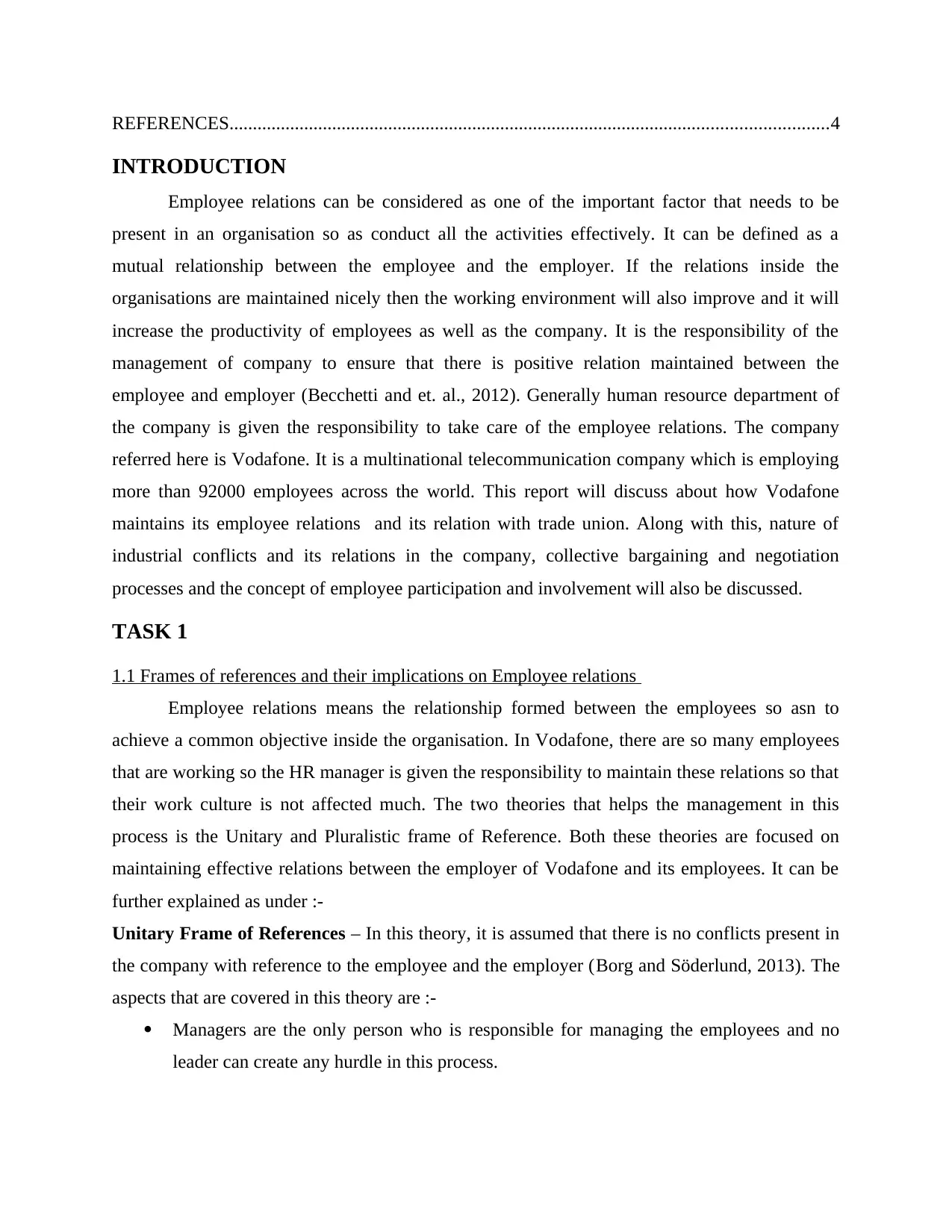
REFERENCES................................................................................................................................4
INTRODUCTION
Employee relations can be considered as one of the important factor that needs to be
present in an organisation so as conduct all the activities effectively. It can be defined as a
mutual relationship between the employee and the employer. If the relations inside the
organisations are maintained nicely then the working environment will also improve and it will
increase the productivity of employees as well as the company. It is the responsibility of the
management of company to ensure that there is positive relation maintained between the
employee and employer (Becchetti and et. al., 2012). Generally human resource department of
the company is given the responsibility to take care of the employee relations. The company
referred here is Vodafone. It is a multinational telecommunication company which is employing
more than 92000 employees across the world. This report will discuss about how Vodafone
maintains its employee relations and its relation with trade union. Along with this, nature of
industrial conflicts and its relations in the company, collective bargaining and negotiation
processes and the concept of employee participation and involvement will also be discussed.
TASK 1
1.1 Frames of references and their implications on Employee relations
Employee relations means the relationship formed between the employees so asn to
achieve a common objective inside the organisation. In Vodafone, there are so many employees
that are working so the HR manager is given the responsibility to maintain these relations so that
their work culture is not affected much. The two theories that helps the management in this
process is the Unitary and Pluralistic frame of Reference. Both these theories are focused on
maintaining effective relations between the employer of Vodafone and its employees. It can be
further explained as under :-
Unitary Frame of References – In this theory, it is assumed that there is no conflicts present in
the company with reference to the employee and the employer (Borg and Söderlund, 2013). The
aspects that are covered in this theory are :-
Managers are the only person who is responsible for managing the employees and no
leader can create any hurdle in this process.
INTRODUCTION
Employee relations can be considered as one of the important factor that needs to be
present in an organisation so as conduct all the activities effectively. It can be defined as a
mutual relationship between the employee and the employer. If the relations inside the
organisations are maintained nicely then the working environment will also improve and it will
increase the productivity of employees as well as the company. It is the responsibility of the
management of company to ensure that there is positive relation maintained between the
employee and employer (Becchetti and et. al., 2012). Generally human resource department of
the company is given the responsibility to take care of the employee relations. The company
referred here is Vodafone. It is a multinational telecommunication company which is employing
more than 92000 employees across the world. This report will discuss about how Vodafone
maintains its employee relations and its relation with trade union. Along with this, nature of
industrial conflicts and its relations in the company, collective bargaining and negotiation
processes and the concept of employee participation and involvement will also be discussed.
TASK 1
1.1 Frames of references and their implications on Employee relations
Employee relations means the relationship formed between the employees so asn to
achieve a common objective inside the organisation. In Vodafone, there are so many employees
that are working so the HR manager is given the responsibility to maintain these relations so that
their work culture is not affected much. The two theories that helps the management in this
process is the Unitary and Pluralistic frame of Reference. Both these theories are focused on
maintaining effective relations between the employer of Vodafone and its employees. It can be
further explained as under :-
Unitary Frame of References – In this theory, it is assumed that there is no conflicts present in
the company with reference to the employee and the employer (Borg and Söderlund, 2013). The
aspects that are covered in this theory are :-
Managers are the only person who is responsible for managing the employees and no
leader can create any hurdle in this process.
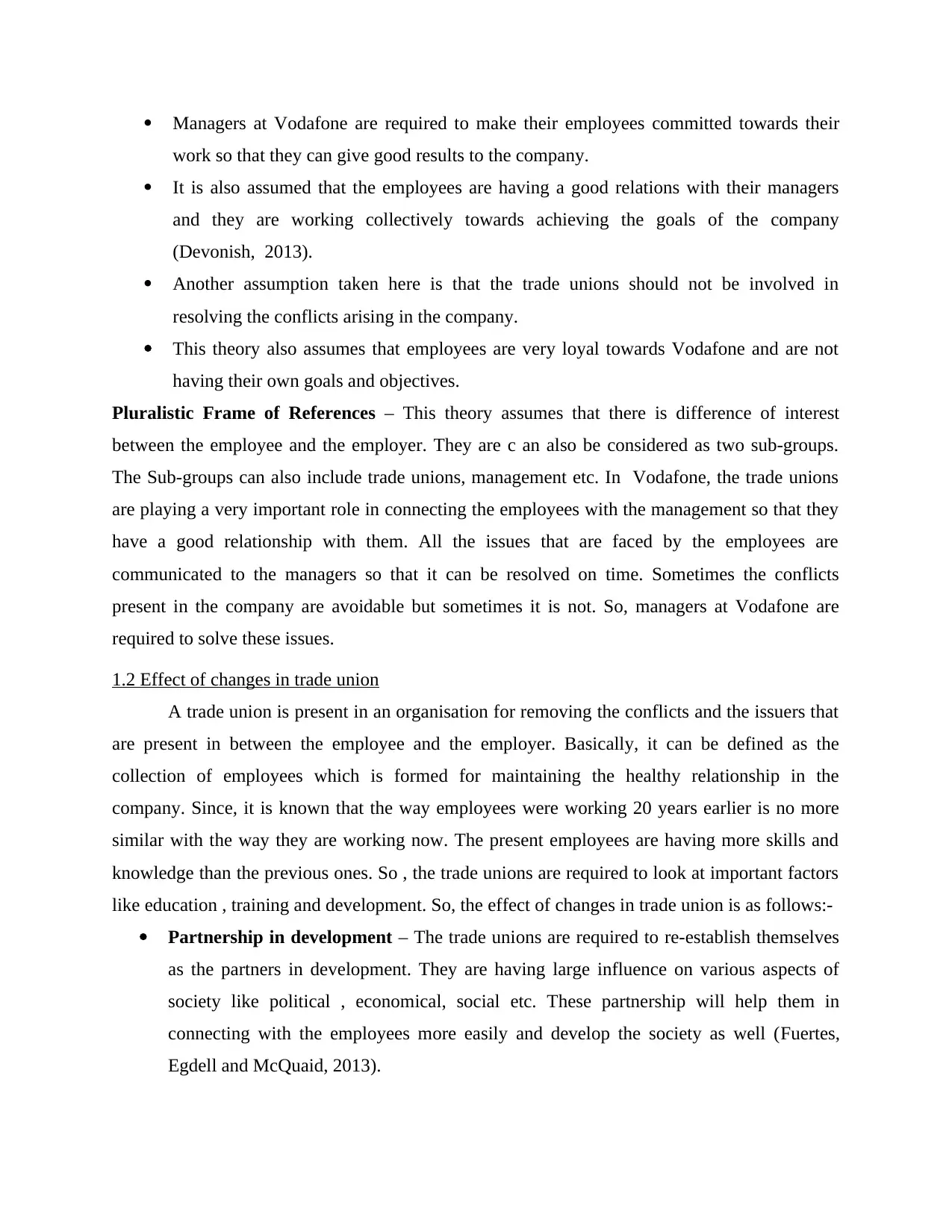
Managers at Vodafone are required to make their employees committed towards their
work so that they can give good results to the company.
It is also assumed that the employees are having a good relations with their managers
and they are working collectively towards achieving the goals of the company
(Devonish, 2013).
Another assumption taken here is that the trade unions should not be involved in
resolving the conflicts arising in the company.
This theory also assumes that employees are very loyal towards Vodafone and are not
having their own goals and objectives.
Pluralistic Frame of References – This theory assumes that there is difference of interest
between the employee and the employer. They are c an also be considered as two sub-groups.
The Sub-groups can also include trade unions, management etc. In Vodafone, the trade unions
are playing a very important role in connecting the employees with the management so that they
have a good relationship with them. All the issues that are faced by the employees are
communicated to the managers so that it can be resolved on time. Sometimes the conflicts
present in the company are avoidable but sometimes it is not. So, managers at Vodafone are
required to solve these issues.
1.2 Effect of changes in trade union
A trade union is present in an organisation for removing the conflicts and the issuers that
are present in between the employee and the employer. Basically, it can be defined as the
collection of employees which is formed for maintaining the healthy relationship in the
company. Since, it is known that the way employees were working 20 years earlier is no more
similar with the way they are working now. The present employees are having more skills and
knowledge than the previous ones. So , the trade unions are required to look at important factors
like education , training and development. So, the effect of changes in trade union is as follows:-
Partnership in development – The trade unions are required to re-establish themselves
as the partners in development. They are having large influence on various aspects of
society like political , economical, social etc. These partnership will help them in
connecting with the employees more easily and develop the society as well (Fuertes,
Egdell and McQuaid, 2013).
work so that they can give good results to the company.
It is also assumed that the employees are having a good relations with their managers
and they are working collectively towards achieving the goals of the company
(Devonish, 2013).
Another assumption taken here is that the trade unions should not be involved in
resolving the conflicts arising in the company.
This theory also assumes that employees are very loyal towards Vodafone and are not
having their own goals and objectives.
Pluralistic Frame of References – This theory assumes that there is difference of interest
between the employee and the employer. They are c an also be considered as two sub-groups.
The Sub-groups can also include trade unions, management etc. In Vodafone, the trade unions
are playing a very important role in connecting the employees with the management so that they
have a good relationship with them. All the issues that are faced by the employees are
communicated to the managers so that it can be resolved on time. Sometimes the conflicts
present in the company are avoidable but sometimes it is not. So, managers at Vodafone are
required to solve these issues.
1.2 Effect of changes in trade union
A trade union is present in an organisation for removing the conflicts and the issuers that
are present in between the employee and the employer. Basically, it can be defined as the
collection of employees which is formed for maintaining the healthy relationship in the
company. Since, it is known that the way employees were working 20 years earlier is no more
similar with the way they are working now. The present employees are having more skills and
knowledge than the previous ones. So , the trade unions are required to look at important factors
like education , training and development. So, the effect of changes in trade union is as follows:-
Partnership in development – The trade unions are required to re-establish themselves
as the partners in development. They are having large influence on various aspects of
society like political , economical, social etc. These partnership will help them in
connecting with the employees more easily and develop the society as well (Fuertes,
Egdell and McQuaid, 2013).
Secure Best Marks with AI Grader
Need help grading? Try our AI Grader for instant feedback on your assignments.
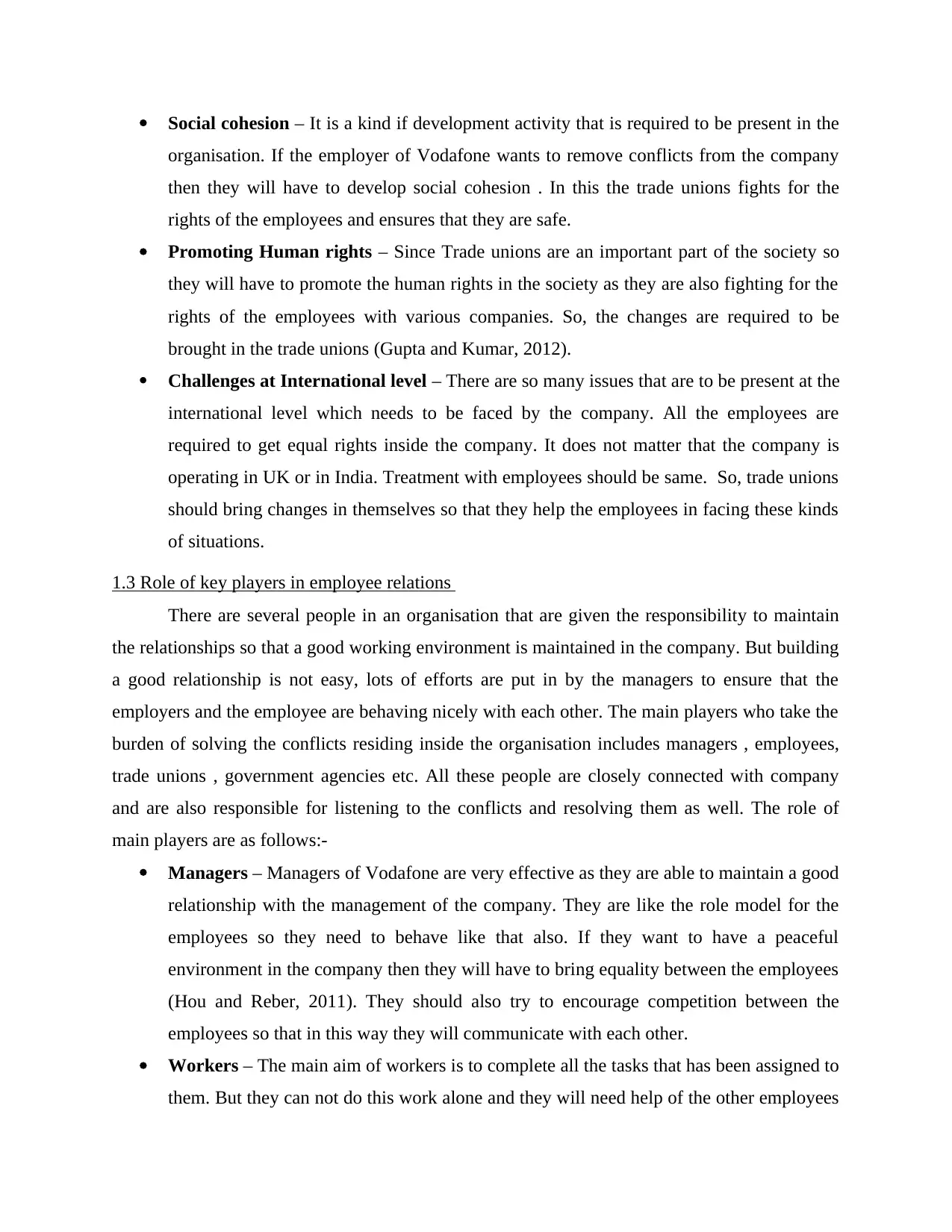
Social cohesion – It is a kind if development activity that is required to be present in the
organisation. If the employer of Vodafone wants to remove conflicts from the company
then they will have to develop social cohesion . In this the trade unions fights for the
rights of the employees and ensures that they are safe.
Promoting Human rights – Since Trade unions are an important part of the society so
they will have to promote the human rights in the society as they are also fighting for the
rights of the employees with various companies. So, the changes are required to be
brought in the trade unions (Gupta and Kumar, 2012).
Challenges at International level – There are so many issues that are to be present at the
international level which needs to be faced by the company. All the employees are
required to get equal rights inside the company. It does not matter that the company is
operating in UK or in India. Treatment with employees should be same. So, trade unions
should bring changes in themselves so that they help the employees in facing these kinds
of situations.
1.3 Role of key players in employee relations
There are several people in an organisation that are given the responsibility to maintain
the relationships so that a good working environment is maintained in the company. But building
a good relationship is not easy, lots of efforts are put in by the managers to ensure that the
employers and the employee are behaving nicely with each other. The main players who take the
burden of solving the conflicts residing inside the organisation includes managers , employees,
trade unions , government agencies etc. All these people are closely connected with company
and are also responsible for listening to the conflicts and resolving them as well. The role of
main players are as follows:-
Managers – Managers of Vodafone are very effective as they are able to maintain a good
relationship with the management of the company. They are like the role model for the
employees so they need to behave like that also. If they want to have a peaceful
environment in the company then they will have to bring equality between the employees
(Hou and Reber, 2011). They should also try to encourage competition between the
employees so that in this way they will communicate with each other.
Workers – The main aim of workers is to complete all the tasks that has been assigned to
them. But they can not do this work alone and they will need help of the other employees
organisation. If the employer of Vodafone wants to remove conflicts from the company
then they will have to develop social cohesion . In this the trade unions fights for the
rights of the employees and ensures that they are safe.
Promoting Human rights – Since Trade unions are an important part of the society so
they will have to promote the human rights in the society as they are also fighting for the
rights of the employees with various companies. So, the changes are required to be
brought in the trade unions (Gupta and Kumar, 2012).
Challenges at International level – There are so many issues that are to be present at the
international level which needs to be faced by the company. All the employees are
required to get equal rights inside the company. It does not matter that the company is
operating in UK or in India. Treatment with employees should be same. So, trade unions
should bring changes in themselves so that they help the employees in facing these kinds
of situations.
1.3 Role of key players in employee relations
There are several people in an organisation that are given the responsibility to maintain
the relationships so that a good working environment is maintained in the company. But building
a good relationship is not easy, lots of efforts are put in by the managers to ensure that the
employers and the employee are behaving nicely with each other. The main players who take the
burden of solving the conflicts residing inside the organisation includes managers , employees,
trade unions , government agencies etc. All these people are closely connected with company
and are also responsible for listening to the conflicts and resolving them as well. The role of
main players are as follows:-
Managers – Managers of Vodafone are very effective as they are able to maintain a good
relationship with the management of the company. They are like the role model for the
employees so they need to behave like that also. If they want to have a peaceful
environment in the company then they will have to bring equality between the employees
(Hou and Reber, 2011). They should also try to encourage competition between the
employees so that in this way they will communicate with each other.
Workers – The main aim of workers is to complete all the tasks that has been assigned to
them. But they can not do this work alone and they will need help of the other employees
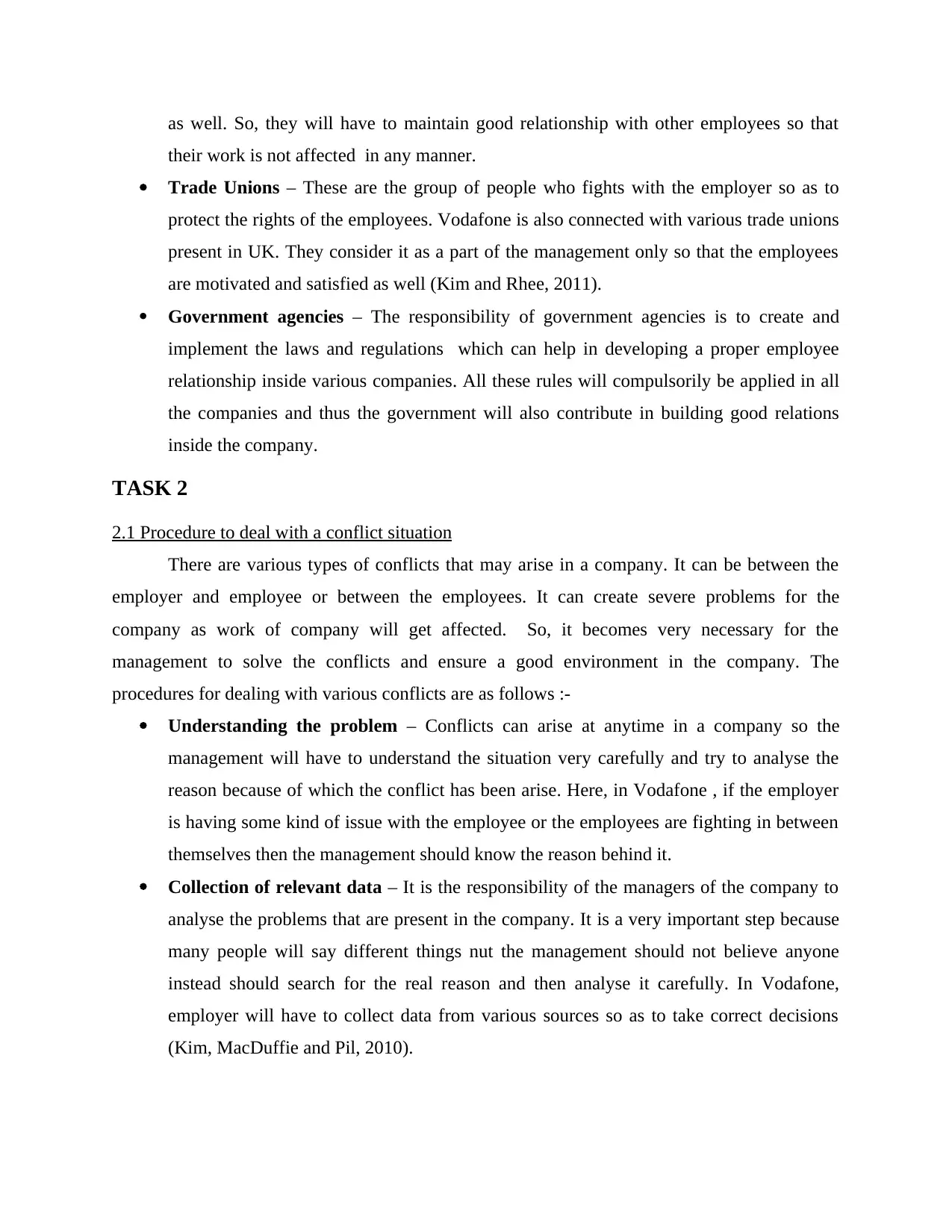
as well. So, they will have to maintain good relationship with other employees so that
their work is not affected in any manner.
Trade Unions – These are the group of people who fights with the employer so as to
protect the rights of the employees. Vodafone is also connected with various trade unions
present in UK. They consider it as a part of the management only so that the employees
are motivated and satisfied as well (Kim and Rhee, 2011).
Government agencies – The responsibility of government agencies is to create and
implement the laws and regulations which can help in developing a proper employee
relationship inside various companies. All these rules will compulsorily be applied in all
the companies and thus the government will also contribute in building good relations
inside the company.
TASK 2
2.1 Procedure to deal with a conflict situation
There are various types of conflicts that may arise in a company. It can be between the
employer and employee or between the employees. It can create severe problems for the
company as work of company will get affected. So, it becomes very necessary for the
management to solve the conflicts and ensure a good environment in the company. The
procedures for dealing with various conflicts are as follows :-
Understanding the problem – Conflicts can arise at anytime in a company so the
management will have to understand the situation very carefully and try to analyse the
reason because of which the conflict has been arise. Here, in Vodafone , if the employer
is having some kind of issue with the employee or the employees are fighting in between
themselves then the management should know the reason behind it.
Collection of relevant data – It is the responsibility of the managers of the company to
analyse the problems that are present in the company. It is a very important step because
many people will say different things nut the management should not believe anyone
instead should search for the real reason and then analyse it carefully. In Vodafone,
employer will have to collect data from various sources so as to take correct decisions
(Kim, MacDuffie and Pil, 2010).
their work is not affected in any manner.
Trade Unions – These are the group of people who fights with the employer so as to
protect the rights of the employees. Vodafone is also connected with various trade unions
present in UK. They consider it as a part of the management only so that the employees
are motivated and satisfied as well (Kim and Rhee, 2011).
Government agencies – The responsibility of government agencies is to create and
implement the laws and regulations which can help in developing a proper employee
relationship inside various companies. All these rules will compulsorily be applied in all
the companies and thus the government will also contribute in building good relations
inside the company.
TASK 2
2.1 Procedure to deal with a conflict situation
There are various types of conflicts that may arise in a company. It can be between the
employer and employee or between the employees. It can create severe problems for the
company as work of company will get affected. So, it becomes very necessary for the
management to solve the conflicts and ensure a good environment in the company. The
procedures for dealing with various conflicts are as follows :-
Understanding the problem – Conflicts can arise at anytime in a company so the
management will have to understand the situation very carefully and try to analyse the
reason because of which the conflict has been arise. Here, in Vodafone , if the employer
is having some kind of issue with the employee or the employees are fighting in between
themselves then the management should know the reason behind it.
Collection of relevant data – It is the responsibility of the managers of the company to
analyse the problems that are present in the company. It is a very important step because
many people will say different things nut the management should not believe anyone
instead should search for the real reason and then analyse it carefully. In Vodafone,
employer will have to collect data from various sources so as to take correct decisions
(Kim, MacDuffie and Pil, 2010).
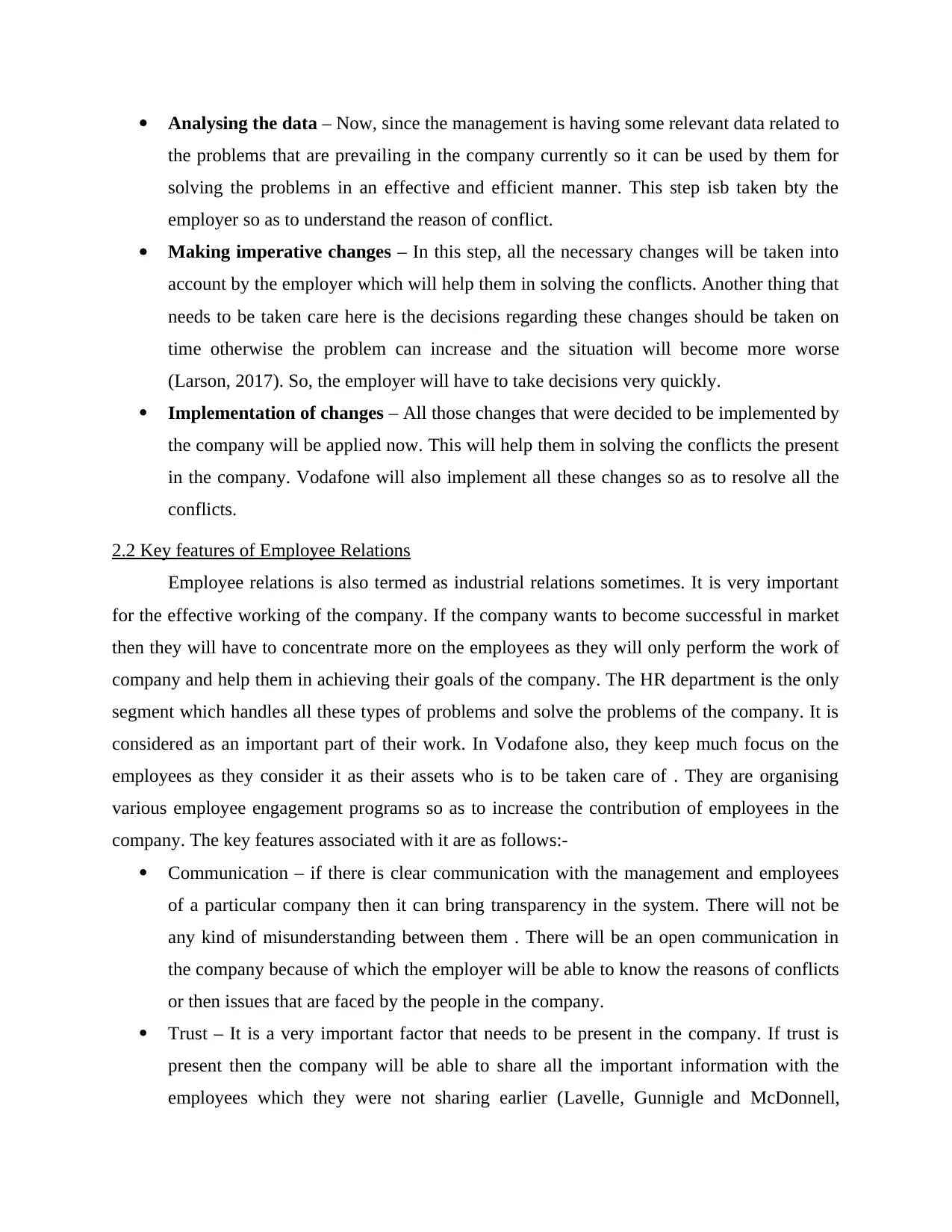
Analysing the data – Now, since the management is having some relevant data related to
the problems that are prevailing in the company currently so it can be used by them for
solving the problems in an effective and efficient manner. This step isb taken bty the
employer so as to understand the reason of conflict.
Making imperative changes – In this step, all the necessary changes will be taken into
account by the employer which will help them in solving the conflicts. Another thing that
needs to be taken care here is the decisions regarding these changes should be taken on
time otherwise the problem can increase and the situation will become more worse
(Larson, 2017). So, the employer will have to take decisions very quickly.
Implementation of changes – All those changes that were decided to be implemented by
the company will be applied now. This will help them in solving the conflicts the present
in the company. Vodafone will also implement all these changes so as to resolve all the
conflicts.
2.2 Key features of Employee Relations
Employee relations is also termed as industrial relations sometimes. It is very important
for the effective working of the company. If the company wants to become successful in market
then they will have to concentrate more on the employees as they will only perform the work of
company and help them in achieving their goals of the company. The HR department is the only
segment which handles all these types of problems and solve the problems of the company. It is
considered as an important part of their work. In Vodafone also, they keep much focus on the
employees as they consider it as their assets who is to be taken care of . They are organising
various employee engagement programs so as to increase the contribution of employees in the
company. The key features associated with it are as follows:-
Communication – if there is clear communication with the management and employees
of a particular company then it can bring transparency in the system. There will not be
any kind of misunderstanding between them . There will be an open communication in
the company because of which the employer will be able to know the reasons of conflicts
or then issues that are faced by the people in the company.
Trust – It is a very important factor that needs to be present in the company. If trust is
present then the company will be able to share all the important information with the
employees which they were not sharing earlier (Lavelle, Gunnigle and McDonnell,
the problems that are prevailing in the company currently so it can be used by them for
solving the problems in an effective and efficient manner. This step isb taken bty the
employer so as to understand the reason of conflict.
Making imperative changes – In this step, all the necessary changes will be taken into
account by the employer which will help them in solving the conflicts. Another thing that
needs to be taken care here is the decisions regarding these changes should be taken on
time otherwise the problem can increase and the situation will become more worse
(Larson, 2017). So, the employer will have to take decisions very quickly.
Implementation of changes – All those changes that were decided to be implemented by
the company will be applied now. This will help them in solving the conflicts the present
in the company. Vodafone will also implement all these changes so as to resolve all the
conflicts.
2.2 Key features of Employee Relations
Employee relations is also termed as industrial relations sometimes. It is very important
for the effective working of the company. If the company wants to become successful in market
then they will have to concentrate more on the employees as they will only perform the work of
company and help them in achieving their goals of the company. The HR department is the only
segment which handles all these types of problems and solve the problems of the company. It is
considered as an important part of their work. In Vodafone also, they keep much focus on the
employees as they consider it as their assets who is to be taken care of . They are organising
various employee engagement programs so as to increase the contribution of employees in the
company. The key features associated with it are as follows:-
Communication – if there is clear communication with the management and employees
of a particular company then it can bring transparency in the system. There will not be
any kind of misunderstanding between them . There will be an open communication in
the company because of which the employer will be able to know the reasons of conflicts
or then issues that are faced by the people in the company.
Trust – It is a very important factor that needs to be present in the company. If trust is
present then the company will be able to share all the important information with the
employees which they were not sharing earlier (Lavelle, Gunnigle and McDonnell,
Paraphrase This Document
Need a fresh take? Get an instant paraphrase of this document with our AI Paraphraser
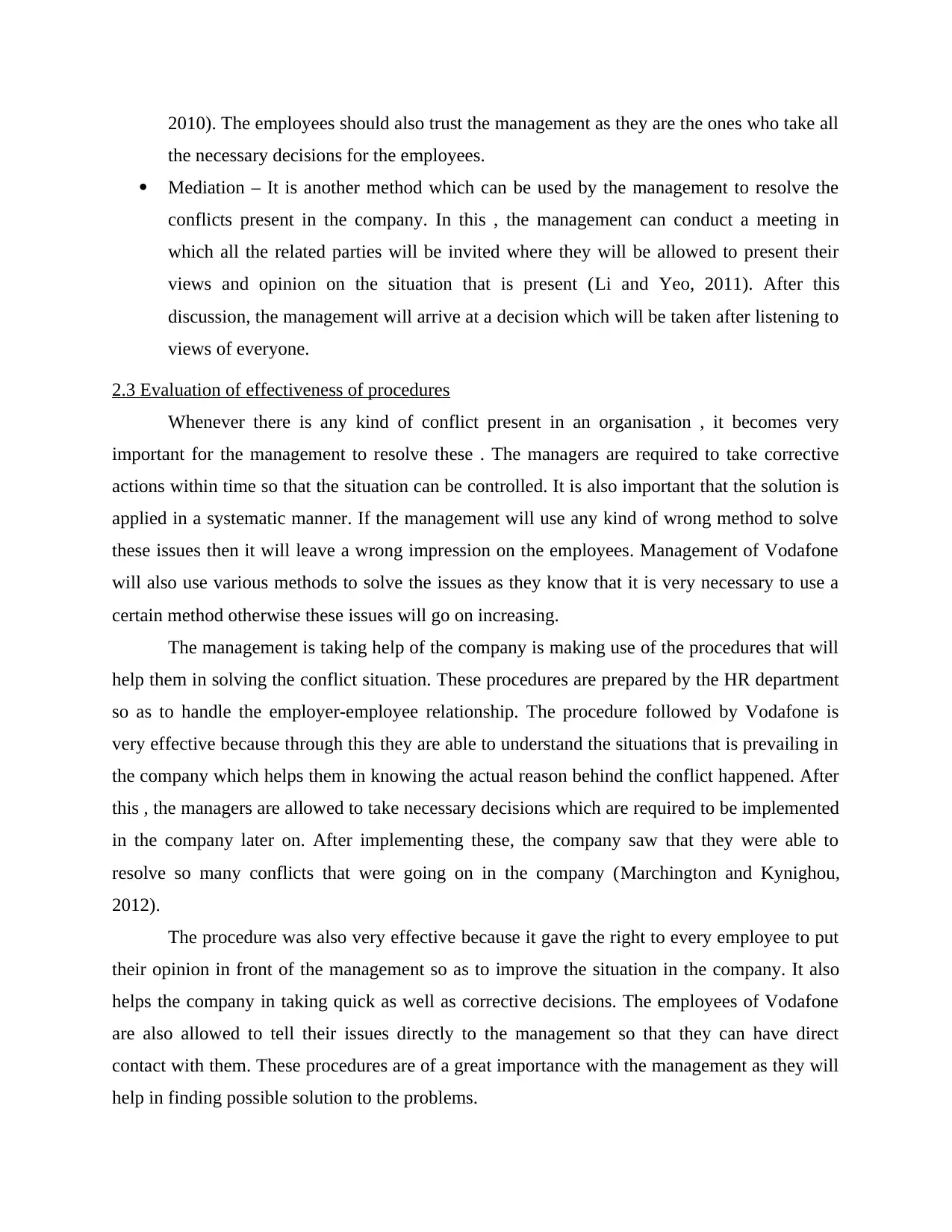
2010). The employees should also trust the management as they are the ones who take all
the necessary decisions for the employees.
Mediation – It is another method which can be used by the management to resolve the
conflicts present in the company. In this , the management can conduct a meeting in
which all the related parties will be invited where they will be allowed to present their
views and opinion on the situation that is present (Li and Yeo, 2011). After this
discussion, the management will arrive at a decision which will be taken after listening to
views of everyone.
2.3 Evaluation of effectiveness of procedures
Whenever there is any kind of conflict present in an organisation , it becomes very
important for the management to resolve these . The managers are required to take corrective
actions within time so that the situation can be controlled. It is also important that the solution is
applied in a systematic manner. If the management will use any kind of wrong method to solve
these issues then it will leave a wrong impression on the employees. Management of Vodafone
will also use various methods to solve the issues as they know that it is very necessary to use a
certain method otherwise these issues will go on increasing.
The management is taking help of the company is making use of the procedures that will
help them in solving the conflict situation. These procedures are prepared by the HR department
so as to handle the employer-employee relationship. The procedure followed by Vodafone is
very effective because through this they are able to understand the situations that is prevailing in
the company which helps them in knowing the actual reason behind the conflict happened. After
this , the managers are allowed to take necessary decisions which are required to be implemented
in the company later on. After implementing these, the company saw that they were able to
resolve so many conflicts that were going on in the company (Marchington and Kynighou,
2012).
The procedure was also very effective because it gave the right to every employee to put
their opinion in front of the management so as to improve the situation in the company. It also
helps the company in taking quick as well as corrective decisions. The employees of Vodafone
are also allowed to tell their issues directly to the management so that they can have direct
contact with them. These procedures are of a great importance with the management as they will
help in finding possible solution to the problems.
the necessary decisions for the employees.
Mediation – It is another method which can be used by the management to resolve the
conflicts present in the company. In this , the management can conduct a meeting in
which all the related parties will be invited where they will be allowed to present their
views and opinion on the situation that is present (Li and Yeo, 2011). After this
discussion, the management will arrive at a decision which will be taken after listening to
views of everyone.
2.3 Evaluation of effectiveness of procedures
Whenever there is any kind of conflict present in an organisation , it becomes very
important for the management to resolve these . The managers are required to take corrective
actions within time so that the situation can be controlled. It is also important that the solution is
applied in a systematic manner. If the management will use any kind of wrong method to solve
these issues then it will leave a wrong impression on the employees. Management of Vodafone
will also use various methods to solve the issues as they know that it is very necessary to use a
certain method otherwise these issues will go on increasing.
The management is taking help of the company is making use of the procedures that will
help them in solving the conflict situation. These procedures are prepared by the HR department
so as to handle the employer-employee relationship. The procedure followed by Vodafone is
very effective because through this they are able to understand the situations that is prevailing in
the company which helps them in knowing the actual reason behind the conflict happened. After
this , the managers are allowed to take necessary decisions which are required to be implemented
in the company later on. After implementing these, the company saw that they were able to
resolve so many conflicts that were going on in the company (Marchington and Kynighou,
2012).
The procedure was also very effective because it gave the right to every employee to put
their opinion in front of the management so as to improve the situation in the company. It also
helps the company in taking quick as well as corrective decisions. The employees of Vodafone
are also allowed to tell their issues directly to the management so that they can have direct
contact with them. These procedures are of a great importance with the management as they will
help in finding possible solution to the problems.
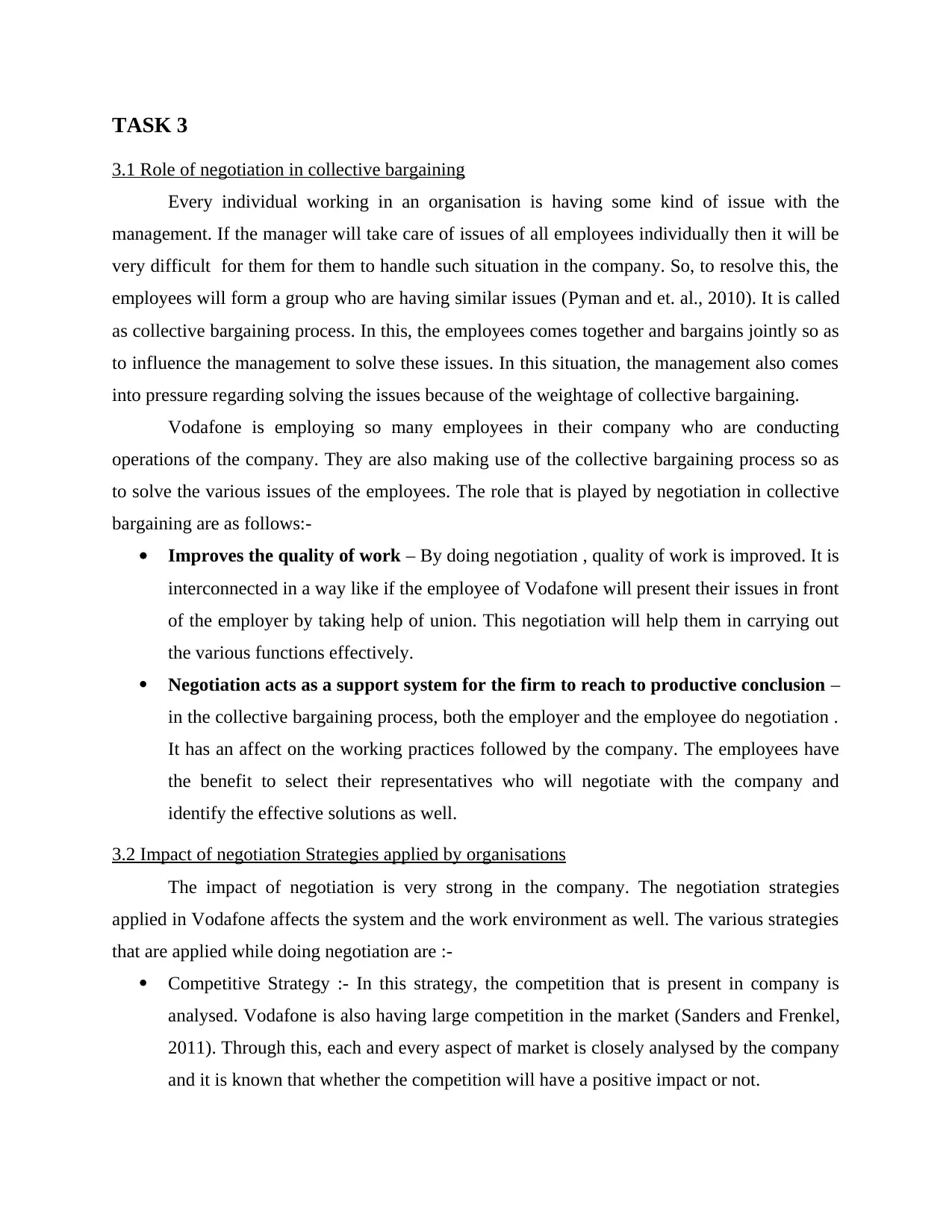
TASK 3
3.1 Role of negotiation in collective bargaining
Every individual working in an organisation is having some kind of issue with the
management. If the manager will take care of issues of all employees individually then it will be
very difficult for them for them to handle such situation in the company. So, to resolve this, the
employees will form a group who are having similar issues (Pyman and et. al., 2010). It is called
as collective bargaining process. In this, the employees comes together and bargains jointly so as
to influence the management to solve these issues. In this situation, the management also comes
into pressure regarding solving the issues because of the weightage of collective bargaining.
Vodafone is employing so many employees in their company who are conducting
operations of the company. They are also making use of the collective bargaining process so as
to solve the various issues of the employees. The role that is played by negotiation in collective
bargaining are as follows:-
Improves the quality of work – By doing negotiation , quality of work is improved. It is
interconnected in a way like if the employee of Vodafone will present their issues in front
of the employer by taking help of union. This negotiation will help them in carrying out
the various functions effectively.
Negotiation acts as a support system for the firm to reach to productive conclusion –
in the collective bargaining process, both the employer and the employee do negotiation .
It has an affect on the working practices followed by the company. The employees have
the benefit to select their representatives who will negotiate with the company and
identify the effective solutions as well.
3.2 Impact of negotiation Strategies applied by organisations
The impact of negotiation is very strong in the company. The negotiation strategies
applied in Vodafone affects the system and the work environment as well. The various strategies
that are applied while doing negotiation are :-
Competitive Strategy :- In this strategy, the competition that is present in company is
analysed. Vodafone is also having large competition in the market (Sanders and Frenkel,
2011). Through this, each and every aspect of market is closely analysed by the company
and it is known that whether the competition will have a positive impact or not.
3.1 Role of negotiation in collective bargaining
Every individual working in an organisation is having some kind of issue with the
management. If the manager will take care of issues of all employees individually then it will be
very difficult for them for them to handle such situation in the company. So, to resolve this, the
employees will form a group who are having similar issues (Pyman and et. al., 2010). It is called
as collective bargaining process. In this, the employees comes together and bargains jointly so as
to influence the management to solve these issues. In this situation, the management also comes
into pressure regarding solving the issues because of the weightage of collective bargaining.
Vodafone is employing so many employees in their company who are conducting
operations of the company. They are also making use of the collective bargaining process so as
to solve the various issues of the employees. The role that is played by negotiation in collective
bargaining are as follows:-
Improves the quality of work – By doing negotiation , quality of work is improved. It is
interconnected in a way like if the employee of Vodafone will present their issues in front
of the employer by taking help of union. This negotiation will help them in carrying out
the various functions effectively.
Negotiation acts as a support system for the firm to reach to productive conclusion –
in the collective bargaining process, both the employer and the employee do negotiation .
It has an affect on the working practices followed by the company. The employees have
the benefit to select their representatives who will negotiate with the company and
identify the effective solutions as well.
3.2 Impact of negotiation Strategies applied by organisations
The impact of negotiation is very strong in the company. The negotiation strategies
applied in Vodafone affects the system and the work environment as well. The various strategies
that are applied while doing negotiation are :-
Competitive Strategy :- In this strategy, the competition that is present in company is
analysed. Vodafone is also having large competition in the market (Sanders and Frenkel,
2011). Through this, each and every aspect of market is closely analysed by the company
and it is known that whether the competition will have a positive impact or not.
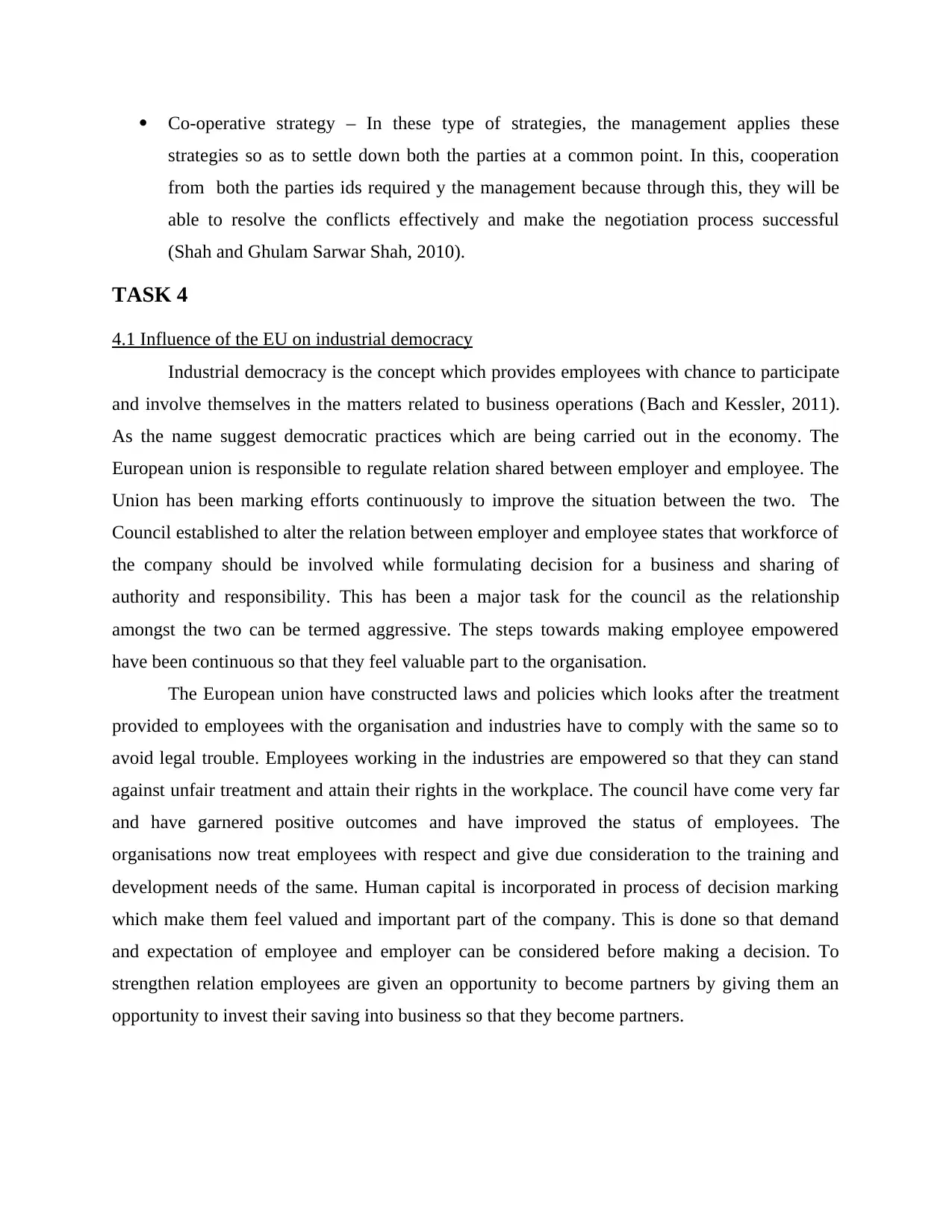
Co-operative strategy – In these type of strategies, the management applies these
strategies so as to settle down both the parties at a common point. In this, cooperation
from both the parties ids required y the management because through this, they will be
able to resolve the conflicts effectively and make the negotiation process successful
(Shah and Ghulam Sarwar Shah, 2010).
TASK 4
4.1 Influence of the EU on industrial democracy
Industrial democracy is the concept which provides employees with chance to participate
and involve themselves in the matters related to business operations (Bach and Kessler, 2011).
As the name suggest democratic practices which are being carried out in the economy. The
European union is responsible to regulate relation shared between employer and employee. The
Union has been marking efforts continuously to improve the situation between the two. The
Council established to alter the relation between employer and employee states that workforce of
the company should be involved while formulating decision for a business and sharing of
authority and responsibility. This has been a major task for the council as the relationship
amongst the two can be termed aggressive. The steps towards making employee empowered
have been continuous so that they feel valuable part to the organisation.
The European union have constructed laws and policies which looks after the treatment
provided to employees with the organisation and industries have to comply with the same so to
avoid legal trouble. Employees working in the industries are empowered so that they can stand
against unfair treatment and attain their rights in the workplace. The council have come very far
and have garnered positive outcomes and have improved the status of employees. The
organisations now treat employees with respect and give due consideration to the training and
development needs of the same. Human capital is incorporated in process of decision marking
which make them feel valued and important part of the company. This is done so that demand
and expectation of employee and employer can be considered before making a decision. To
strengthen relation employees are given an opportunity to become partners by giving them an
opportunity to invest their saving into business so that they become partners.
strategies so as to settle down both the parties at a common point. In this, cooperation
from both the parties ids required y the management because through this, they will be
able to resolve the conflicts effectively and make the negotiation process successful
(Shah and Ghulam Sarwar Shah, 2010).
TASK 4
4.1 Influence of the EU on industrial democracy
Industrial democracy is the concept which provides employees with chance to participate
and involve themselves in the matters related to business operations (Bach and Kessler, 2011).
As the name suggest democratic practices which are being carried out in the economy. The
European union is responsible to regulate relation shared between employer and employee. The
Union has been marking efforts continuously to improve the situation between the two. The
Council established to alter the relation between employer and employee states that workforce of
the company should be involved while formulating decision for a business and sharing of
authority and responsibility. This has been a major task for the council as the relationship
amongst the two can be termed aggressive. The steps towards making employee empowered
have been continuous so that they feel valuable part to the organisation.
The European union have constructed laws and policies which looks after the treatment
provided to employees with the organisation and industries have to comply with the same so to
avoid legal trouble. Employees working in the industries are empowered so that they can stand
against unfair treatment and attain their rights in the workplace. The council have come very far
and have garnered positive outcomes and have improved the status of employees. The
organisations now treat employees with respect and give due consideration to the training and
development needs of the same. Human capital is incorporated in process of decision marking
which make them feel valued and important part of the company. This is done so that demand
and expectation of employee and employer can be considered before making a decision. To
strengthen relation employees are given an opportunity to become partners by giving them an
opportunity to invest their saving into business so that they become partners.
Secure Best Marks with AI Grader
Need help grading? Try our AI Grader for instant feedback on your assignments.
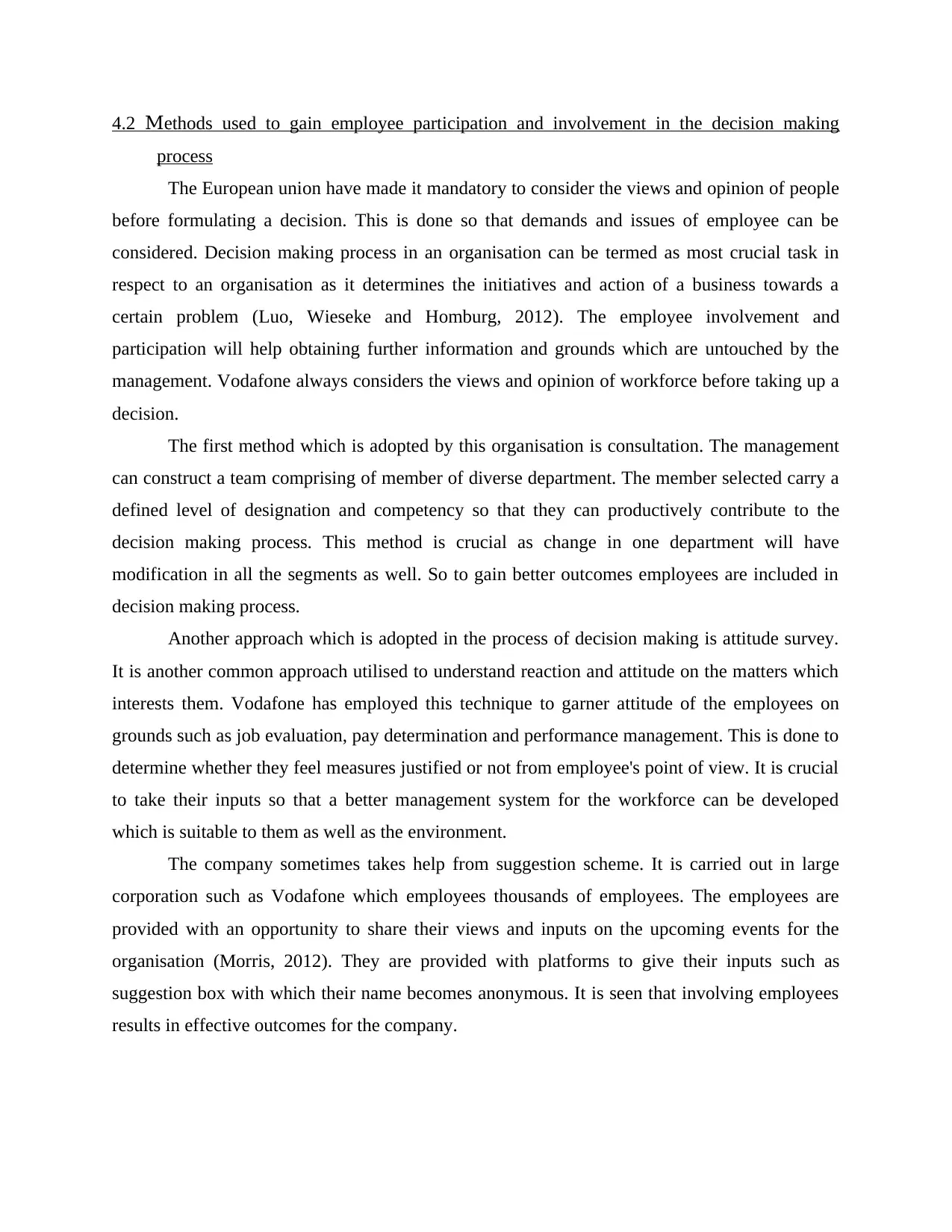
4.2 Methods used to gain employee participation and involvement in the decision making
process
The European union have made it mandatory to consider the views and opinion of people
before formulating a decision. This is done so that demands and issues of employee can be
considered. Decision making process in an organisation can be termed as most crucial task in
respect to an organisation as it determines the initiatives and action of a business towards a
certain problem (Luo, Wieseke and Homburg, 2012). The employee involvement and
participation will help obtaining further information and grounds which are untouched by the
management. Vodafone always considers the views and opinion of workforce before taking up a
decision.
The first method which is adopted by this organisation is consultation. The management
can construct a team comprising of member of diverse department. The member selected carry a
defined level of designation and competency so that they can productively contribute to the
decision making process. This method is crucial as change in one department will have
modification in all the segments as well. So to gain better outcomes employees are included in
decision making process.
Another approach which is adopted in the process of decision making is attitude survey.
It is another common approach utilised to understand reaction and attitude on the matters which
interests them. Vodafone has employed this technique to garner attitude of the employees on
grounds such as job evaluation, pay determination and performance management. This is done to
determine whether they feel measures justified or not from employee's point of view. It is crucial
to take their inputs so that a better management system for the workforce can be developed
which is suitable to them as well as the environment.
The company sometimes takes help from suggestion scheme. It is carried out in large
corporation such as Vodafone which employees thousands of employees. The employees are
provided with an opportunity to share their views and inputs on the upcoming events for the
organisation (Morris, 2012). They are provided with platforms to give their inputs such as
suggestion box with which their name becomes anonymous. It is seen that involving employees
results in effective outcomes for the company.
process
The European union have made it mandatory to consider the views and opinion of people
before formulating a decision. This is done so that demands and issues of employee can be
considered. Decision making process in an organisation can be termed as most crucial task in
respect to an organisation as it determines the initiatives and action of a business towards a
certain problem (Luo, Wieseke and Homburg, 2012). The employee involvement and
participation will help obtaining further information and grounds which are untouched by the
management. Vodafone always considers the views and opinion of workforce before taking up a
decision.
The first method which is adopted by this organisation is consultation. The management
can construct a team comprising of member of diverse department. The member selected carry a
defined level of designation and competency so that they can productively contribute to the
decision making process. This method is crucial as change in one department will have
modification in all the segments as well. So to gain better outcomes employees are included in
decision making process.
Another approach which is adopted in the process of decision making is attitude survey.
It is another common approach utilised to understand reaction and attitude on the matters which
interests them. Vodafone has employed this technique to garner attitude of the employees on
grounds such as job evaluation, pay determination and performance management. This is done to
determine whether they feel measures justified or not from employee's point of view. It is crucial
to take their inputs so that a better management system for the workforce can be developed
which is suitable to them as well as the environment.
The company sometimes takes help from suggestion scheme. It is carried out in large
corporation such as Vodafone which employees thousands of employees. The employees are
provided with an opportunity to share their views and inputs on the upcoming events for the
organisation (Morris, 2012). They are provided with platforms to give their inputs such as
suggestion box with which their name becomes anonymous. It is seen that involving employees
results in effective outcomes for the company.
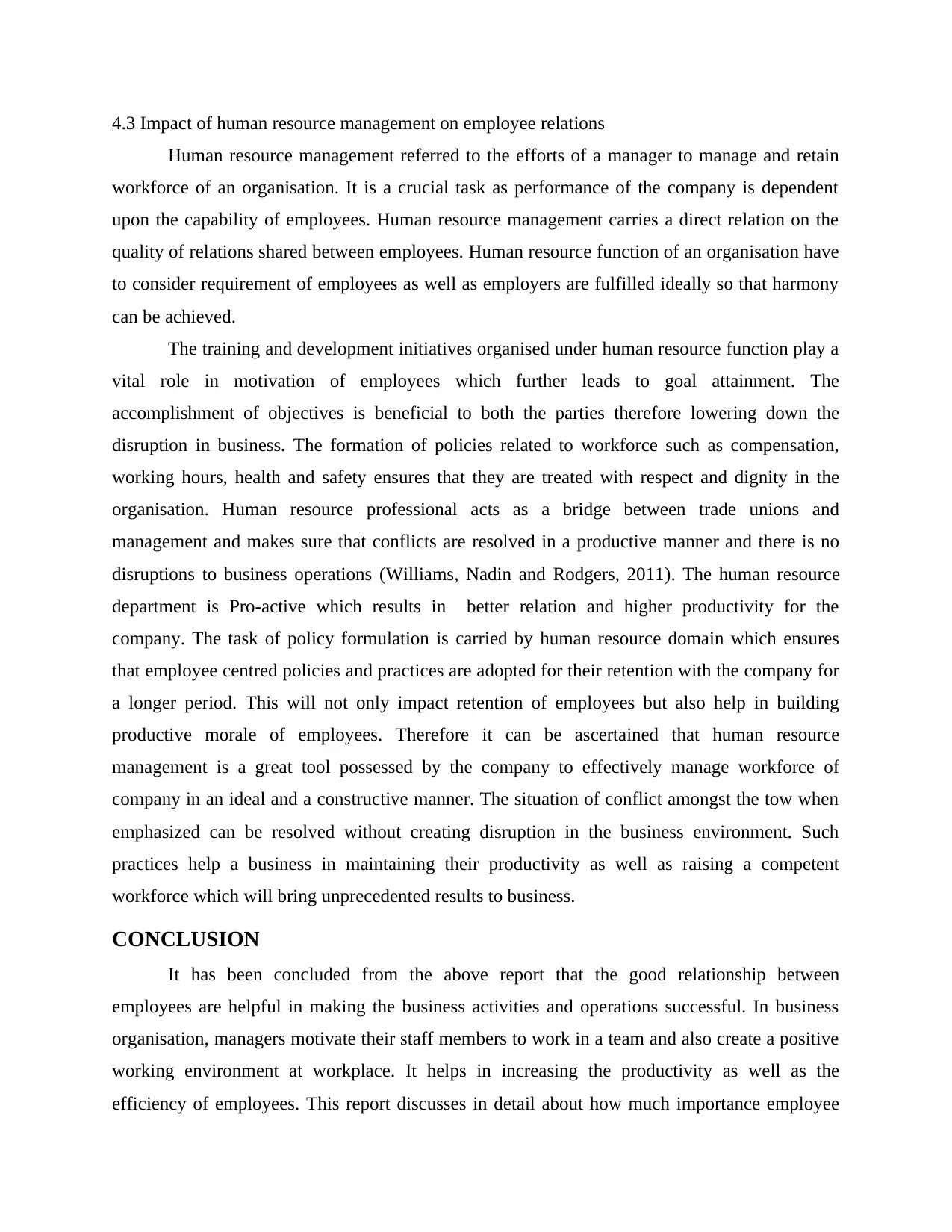
4.3 Impact of human resource management on employee relations
Human resource management referred to the efforts of a manager to manage and retain
workforce of an organisation. It is a crucial task as performance of the company is dependent
upon the capability of employees. Human resource management carries a direct relation on the
quality of relations shared between employees. Human resource function of an organisation have
to consider requirement of employees as well as employers are fulfilled ideally so that harmony
can be achieved.
The training and development initiatives organised under human resource function play a
vital role in motivation of employees which further leads to goal attainment. The
accomplishment of objectives is beneficial to both the parties therefore lowering down the
disruption in business. The formation of policies related to workforce such as compensation,
working hours, health and safety ensures that they are treated with respect and dignity in the
organisation. Human resource professional acts as a bridge between trade unions and
management and makes sure that conflicts are resolved in a productive manner and there is no
disruptions to business operations (Williams, Nadin and Rodgers, 2011). The human resource
department is Pro-active which results in better relation and higher productivity for the
company. The task of policy formulation is carried by human resource domain which ensures
that employee centred policies and practices are adopted for their retention with the company for
a longer period. This will not only impact retention of employees but also help in building
productive morale of employees. Therefore it can be ascertained that human resource
management is a great tool possessed by the company to effectively manage workforce of
company in an ideal and a constructive manner. The situation of conflict amongst the tow when
emphasized can be resolved without creating disruption in the business environment. Such
practices help a business in maintaining their productivity as well as raising a competent
workforce which will bring unprecedented results to business.
CONCLUSION
It has been concluded from the above report that the good relationship between
employees are helpful in making the business activities and operations successful. In business
organisation, managers motivate their staff members to work in a team and also create a positive
working environment at workplace. It helps in increasing the productivity as well as the
efficiency of employees. This report discusses in detail about how much importance employee
Human resource management referred to the efforts of a manager to manage and retain
workforce of an organisation. It is a crucial task as performance of the company is dependent
upon the capability of employees. Human resource management carries a direct relation on the
quality of relations shared between employees. Human resource function of an organisation have
to consider requirement of employees as well as employers are fulfilled ideally so that harmony
can be achieved.
The training and development initiatives organised under human resource function play a
vital role in motivation of employees which further leads to goal attainment. The
accomplishment of objectives is beneficial to both the parties therefore lowering down the
disruption in business. The formation of policies related to workforce such as compensation,
working hours, health and safety ensures that they are treated with respect and dignity in the
organisation. Human resource professional acts as a bridge between trade unions and
management and makes sure that conflicts are resolved in a productive manner and there is no
disruptions to business operations (Williams, Nadin and Rodgers, 2011). The human resource
department is Pro-active which results in better relation and higher productivity for the
company. The task of policy formulation is carried by human resource domain which ensures
that employee centred policies and practices are adopted for their retention with the company for
a longer period. This will not only impact retention of employees but also help in building
productive morale of employees. Therefore it can be ascertained that human resource
management is a great tool possessed by the company to effectively manage workforce of
company in an ideal and a constructive manner. The situation of conflict amongst the tow when
emphasized can be resolved without creating disruption in the business environment. Such
practices help a business in maintaining their productivity as well as raising a competent
workforce which will bring unprecedented results to business.
CONCLUSION
It has been concluded from the above report that the good relationship between
employees are helpful in making the business activities and operations successful. In business
organisation, managers motivate their staff members to work in a team and also create a positive
working environment at workplace. It helps in increasing the productivity as well as the
efficiency of employees. This report discusses in detail about how much importance employee

relations hold in a company. It discussed about how Vodafone maintains its employee relations
and its relation with trade union. Along with this, nature of industrial conflicts and its relations in
the company, collective bargaining and negotiation processes and the concept of employee
participation and involvement has also been discussed.
and its relation with trade union. Along with this, nature of industrial conflicts and its relations in
the company, collective bargaining and negotiation processes and the concept of employee
participation and involvement has also been discussed.
Paraphrase This Document
Need a fresh take? Get an instant paraphrase of this document with our AI Paraphraser
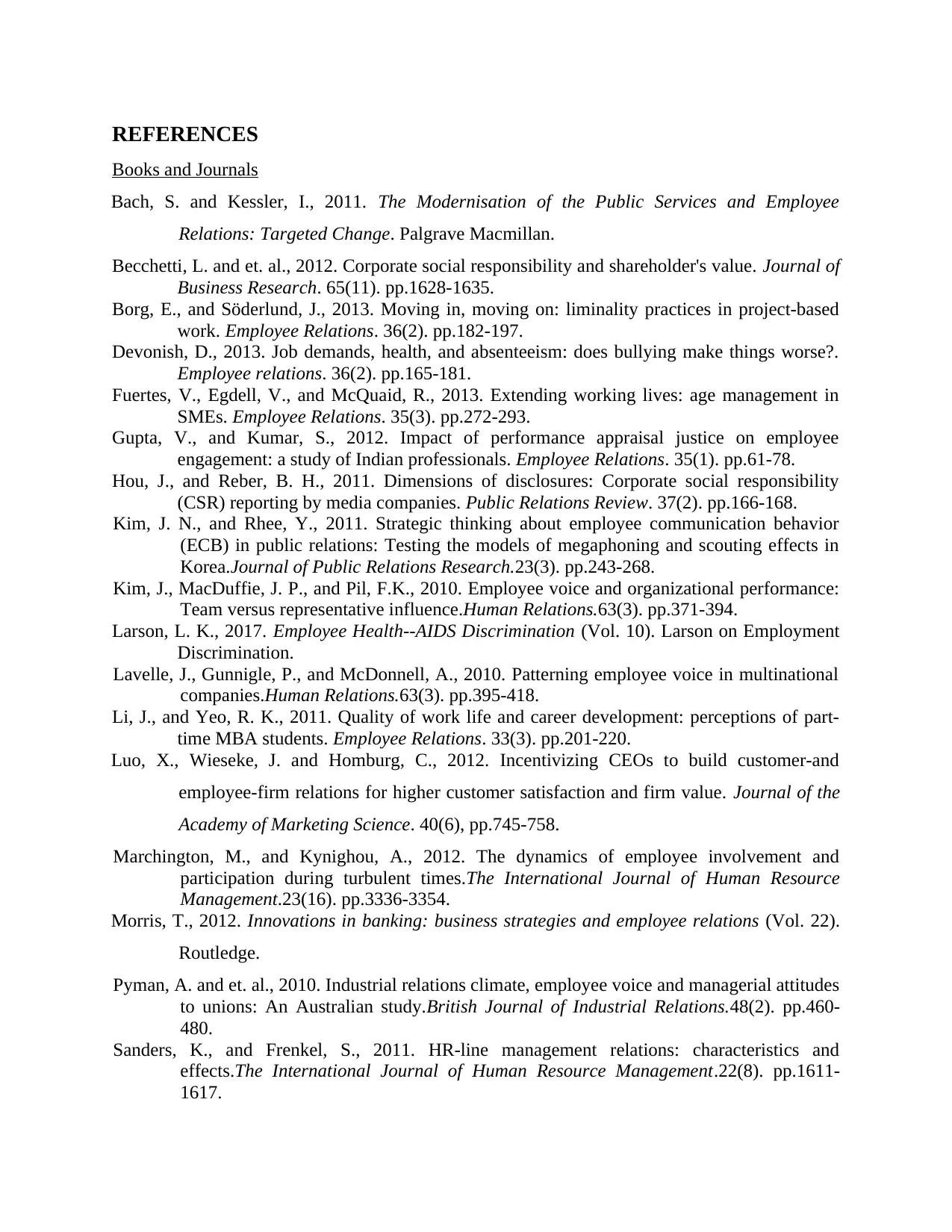
REFERENCES
Books and Journals
Bach, S. and Kessler, I., 2011. The Modernisation of the Public Services and Employee
Relations: Targeted Change. Palgrave Macmillan.
Becchetti, L. and et. al., 2012. Corporate social responsibility and shareholder's value. Journal of
Business Research. 65(11). pp.1628-1635.
Borg, E., and Söderlund, J., 2013. Moving in, moving on: liminality practices in project-based
work. Employee Relations. 36(2). pp.182-197.
Devonish, D., 2013. Job demands, health, and absenteeism: does bullying make things worse?.
Employee relations. 36(2). pp.165-181.
Fuertes, V., Egdell, V., and McQuaid, R., 2013. Extending working lives: age management in
SMEs. Employee Relations. 35(3). pp.272-293.
Gupta, V., and Kumar, S., 2012. Impact of performance appraisal justice on employee
engagement: a study of Indian professionals. Employee Relations. 35(1). pp.61-78.
Hou, J., and Reber, B. H., 2011. Dimensions of disclosures: Corporate social responsibility
(CSR) reporting by media companies. Public Relations Review. 37(2). pp.166-168.
Kim, J. N., and Rhee, Y., 2011. Strategic thinking about employee communication behavior
(ECB) in public relations: Testing the models of megaphoning and scouting effects in
Korea.Journal of Public Relations Research.23(3). pp.243-268.
Kim, J., MacDuffie, J. P., and Pil, F.K., 2010. Employee voice and organizational performance:
Team versus representative influence.Human Relations.63(3). pp.371-394.
Larson, L. K., 2017. Employee Health--AIDS Discrimination (Vol. 10). Larson on Employment
Discrimination.
Lavelle, J., Gunnigle, P., and McDonnell, A., 2010. Patterning employee voice in multinational
companies.Human Relations.63(3). pp.395-418.
Li, J., and Yeo, R. K., 2011. Quality of work life and career development: perceptions of part-
time MBA students. Employee Relations. 33(3). pp.201-220.
Luo, X., Wieseke, J. and Homburg, C., 2012. Incentivizing CEOs to build customer-and
employee-firm relations for higher customer satisfaction and firm value. Journal of the
Academy of Marketing Science. 40(6), pp.745-758.
Marchington, M., and Kynighou, A., 2012. The dynamics of employee involvement and
participation during turbulent times.The International Journal of Human Resource
Management.23(16). pp.3336-3354.
Morris, T., 2012. Innovations in banking: business strategies and employee relations (Vol. 22).
Routledge.
Pyman, A. and et. al., 2010. Industrial relations climate, employee voice and managerial attitudes
to unions: An Australian study.British Journal of Industrial Relations.48(2). pp.460-
480.
Sanders, K., and Frenkel, S., 2011. HR-line management relations: characteristics and
effects.The International Journal of Human Resource Management.22(8). pp.1611-
1617.
Books and Journals
Bach, S. and Kessler, I., 2011. The Modernisation of the Public Services and Employee
Relations: Targeted Change. Palgrave Macmillan.
Becchetti, L. and et. al., 2012. Corporate social responsibility and shareholder's value. Journal of
Business Research. 65(11). pp.1628-1635.
Borg, E., and Söderlund, J., 2013. Moving in, moving on: liminality practices in project-based
work. Employee Relations. 36(2). pp.182-197.
Devonish, D., 2013. Job demands, health, and absenteeism: does bullying make things worse?.
Employee relations. 36(2). pp.165-181.
Fuertes, V., Egdell, V., and McQuaid, R., 2013. Extending working lives: age management in
SMEs. Employee Relations. 35(3). pp.272-293.
Gupta, V., and Kumar, S., 2012. Impact of performance appraisal justice on employee
engagement: a study of Indian professionals. Employee Relations. 35(1). pp.61-78.
Hou, J., and Reber, B. H., 2011. Dimensions of disclosures: Corporate social responsibility
(CSR) reporting by media companies. Public Relations Review. 37(2). pp.166-168.
Kim, J. N., and Rhee, Y., 2011. Strategic thinking about employee communication behavior
(ECB) in public relations: Testing the models of megaphoning and scouting effects in
Korea.Journal of Public Relations Research.23(3). pp.243-268.
Kim, J., MacDuffie, J. P., and Pil, F.K., 2010. Employee voice and organizational performance:
Team versus representative influence.Human Relations.63(3). pp.371-394.
Larson, L. K., 2017. Employee Health--AIDS Discrimination (Vol. 10). Larson on Employment
Discrimination.
Lavelle, J., Gunnigle, P., and McDonnell, A., 2010. Patterning employee voice in multinational
companies.Human Relations.63(3). pp.395-418.
Li, J., and Yeo, R. K., 2011. Quality of work life and career development: perceptions of part-
time MBA students. Employee Relations. 33(3). pp.201-220.
Luo, X., Wieseke, J. and Homburg, C., 2012. Incentivizing CEOs to build customer-and
employee-firm relations for higher customer satisfaction and firm value. Journal of the
Academy of Marketing Science. 40(6), pp.745-758.
Marchington, M., and Kynighou, A., 2012. The dynamics of employee involvement and
participation during turbulent times.The International Journal of Human Resource
Management.23(16). pp.3336-3354.
Morris, T., 2012. Innovations in banking: business strategies and employee relations (Vol. 22).
Routledge.
Pyman, A. and et. al., 2010. Industrial relations climate, employee voice and managerial attitudes
to unions: An Australian study.British Journal of Industrial Relations.48(2). pp.460-
480.
Sanders, K., and Frenkel, S., 2011. HR-line management relations: characteristics and
effects.The International Journal of Human Resource Management.22(8). pp.1611-
1617.
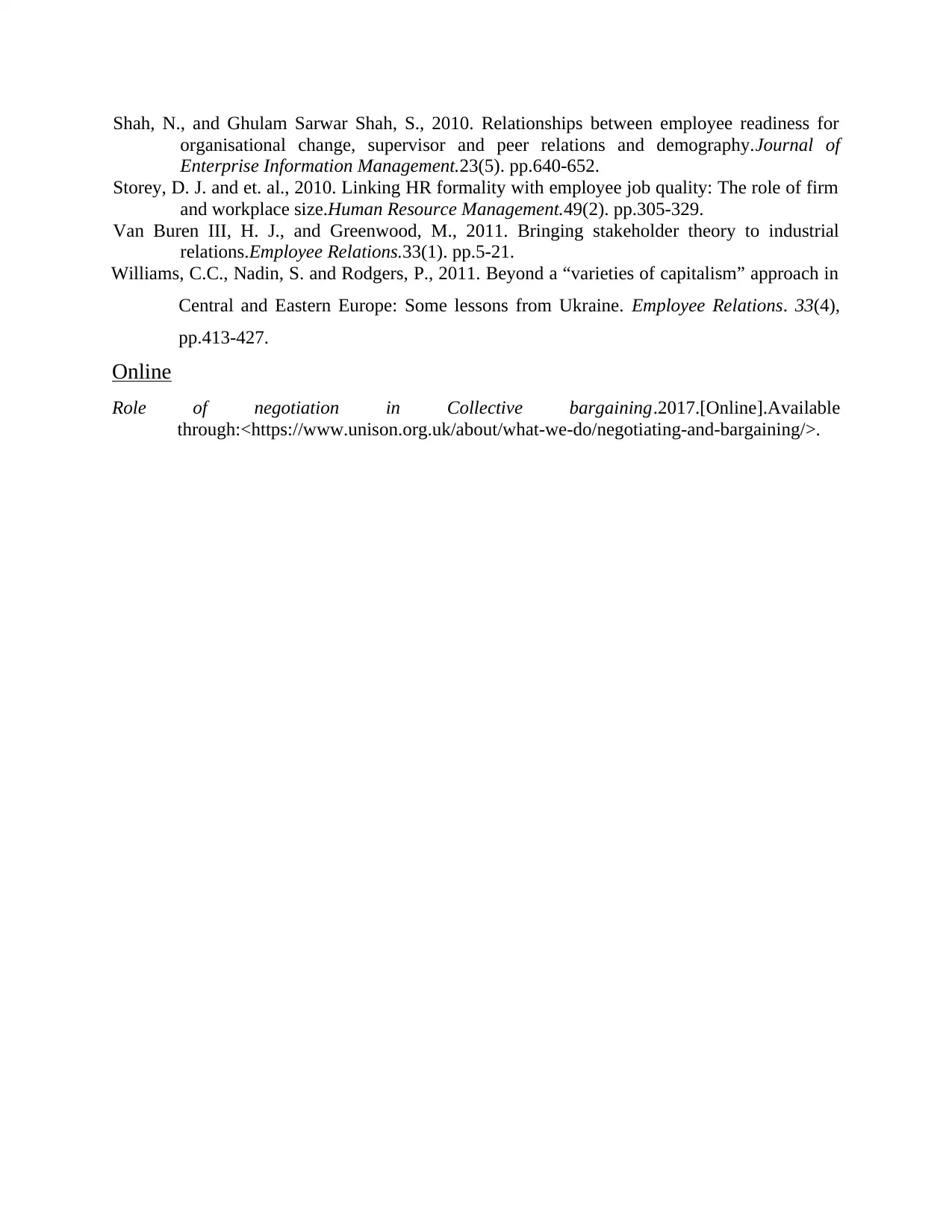
Shah, N., and Ghulam Sarwar Shah, S., 2010. Relationships between employee readiness for
organisational change, supervisor and peer relations and demography.Journal of
Enterprise Information Management.23(5). pp.640-652.
Storey, D. J. and et. al., 2010. Linking HR formality with employee job quality: The role of firm
and workplace size.Human Resource Management.49(2). pp.305-329.
Van Buren III, H. J., and Greenwood, M., 2011. Bringing stakeholder theory to industrial
relations.Employee Relations.33(1). pp.5-21.
Williams, C.C., Nadin, S. and Rodgers, P., 2011. Beyond a “varieties of capitalism” approach in
Central and Eastern Europe: Some lessons from Ukraine. Employee Relations. 33(4),
pp.413-427.
Online
Role of negotiation in Collective bargaining.2017.[Online].Available
through:<https://www.unison.org.uk/about/what-we-do/negotiating-and-bargaining/>.
organisational change, supervisor and peer relations and demography.Journal of
Enterprise Information Management.23(5). pp.640-652.
Storey, D. J. and et. al., 2010. Linking HR formality with employee job quality: The role of firm
and workplace size.Human Resource Management.49(2). pp.305-329.
Van Buren III, H. J., and Greenwood, M., 2011. Bringing stakeholder theory to industrial
relations.Employee Relations.33(1). pp.5-21.
Williams, C.C., Nadin, S. and Rodgers, P., 2011. Beyond a “varieties of capitalism” approach in
Central and Eastern Europe: Some lessons from Ukraine. Employee Relations. 33(4),
pp.413-427.
Online
Role of negotiation in Collective bargaining.2017.[Online].Available
through:<https://www.unison.org.uk/about/what-we-do/negotiating-and-bargaining/>.
1 out of 15
Related Documents
Your All-in-One AI-Powered Toolkit for Academic Success.
+13062052269
info@desklib.com
Available 24*7 on WhatsApp / Email
![[object Object]](/_next/static/media/star-bottom.7253800d.svg)
Unlock your academic potential
© 2024 | Zucol Services PVT LTD | All rights reserved.





